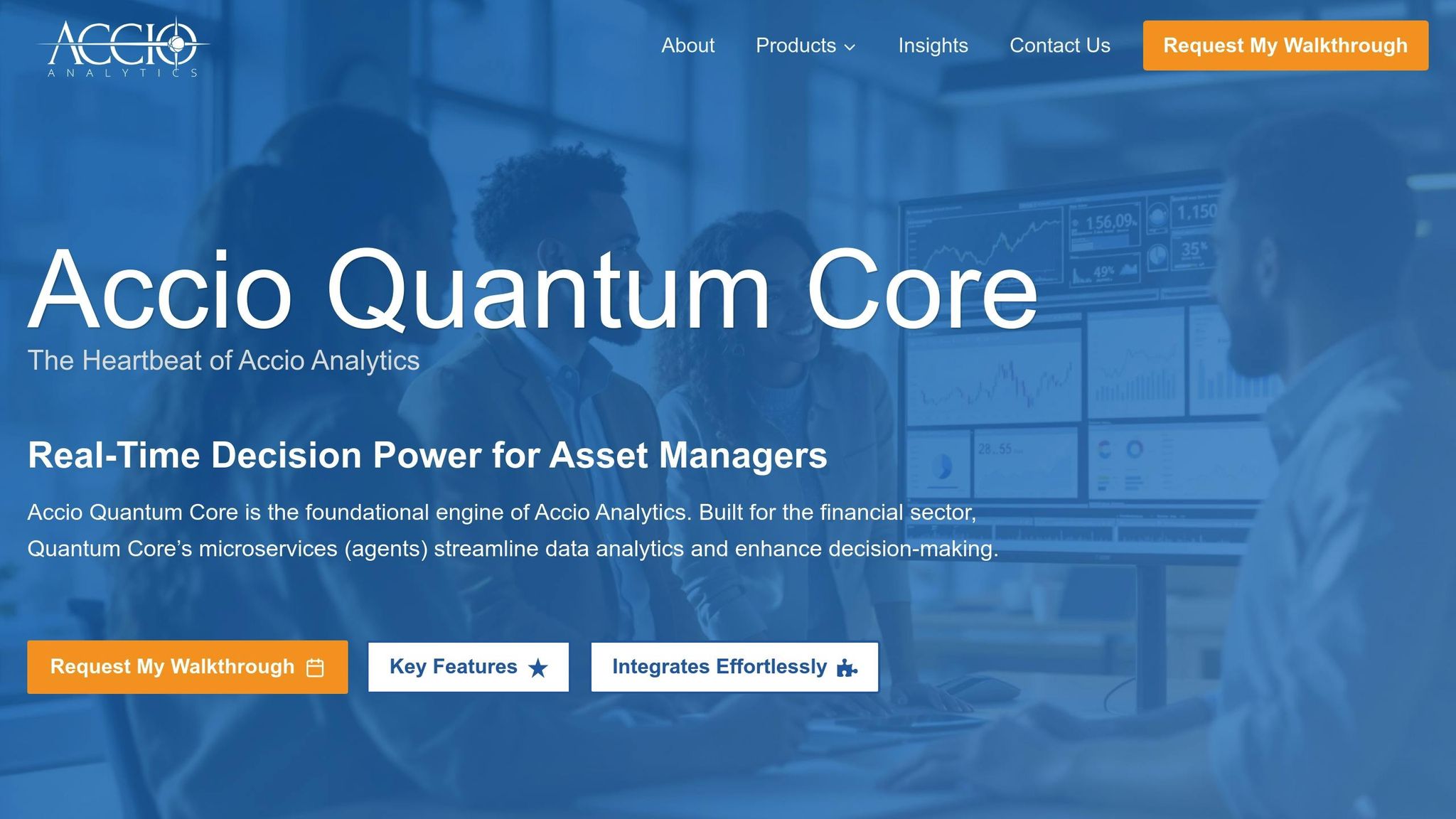AI vs. Manual Compliance Gap Analysis
Accio Analytics Inc.
13 min read
AI is revolutionizing compliance gap analysis, offering faster, more accurate, and scalable solutions compared to manual methods. Here’s what you need to know:
- Manual Compliance: Relies on human expertise to review policies, procedures, and controls. It’s time-consuming, prone to errors, and struggles to keep up with complex regulations.
- AI-Driven Compliance: Automates data analysis, provides real-time monitoring, and reduces human error. AI tools adapt to regulatory changes and deliver consistent results.
Key stats:
- Manual processes take weeks, while AI can complete tasks in hours.
- AI achieves up to 95% accuracy, compared to 60–70% with manual reviews.
- Companies using AI report a 40% reduction in compliance incidents.
Quick Comparison:
| Aspect | Manual Approach | AI-Driven Approach |
|---|---|---|
| Processing Speed | Weeks | Hours |
| Accuracy | 60–70% | Up to 95% |
| Scalability | Limited by staff | Handles large data sets |
| Cost | High labor costs | Lower long-term costs |
AI is transforming compliance, making it faster, more precise, and easier to manage. Organizations still relying on manual methods risk falling behind in today’s fast-changing regulatory environment.
Leveraging AI for Risk & Compliance in Financial Advisory | AI Automation in Service Industries #8
Manual Compliance Gap Analysis: How It Works and Its Limits
Manual compliance gap analysis has long been a cornerstone for identifying where organizations fall short of meeting regulatory requirements. This approach relies heavily on human expertise and detailed processes, but as regulatory demands grow more complex, the limitations of manual methods become increasingly apparent. These challenges highlight the need for more efficient and adaptable solutions.
Manual Methods and Workflows
The process of manual compliance gap analysis typically begins with defining the regulatory scope. This involves identifying the relevant regulations, standards, or frameworks that apply to the organization. From there, compliance teams focus on evaluating current policies, procedures, and controls through a combination of document reviews, observations, and interviews.
The workflow often includes:
- Examining existing documentation to assess how well policies align with regulatory requirements.
- Observing practices firsthand to ensure they match documented procedures.
- Conducting interviews with employees to gain a clearer understanding of how processes function in reality.
Once this evaluation phase is complete, teams identify gaps by comparing current practices against regulatory standards. These gaps might include missing or outdated controls, incomplete documentation, or policies that no longer meet current requirements. For instance, a retail company conducting a PCI compliance gap analysis might discover outdated encryption protocols or weak access controls for safeguarding cardholder data.
Organizations typically perform these comprehensive reviews quarterly or annually, depending on the complexity of their regulatory environment.
Problems with Manual Compliance
Manual methods come with several inherent challenges. One major issue is the time and effort required to manually track and analyze compliance data. This labor-intensive process increases the risk of human error, as even experienced professionals can overlook details or misinterpret complex regulations.
Scaling these methods is another significant hurdle. As businesses grow or face more stringent regulatory oversight, manual compliance processes that worked for smaller organizations often become unmanageable. For example, the 2023 Thomson Reuters Risk & Compliance Survey Report highlighted two key obstacles for compliance teams: a shortage of skilled personnel and insufficient resources.
These challenges not only strain operational capacity but also undermine the accuracy and responsiveness of manual compliance efforts.
Effects on Accuracy and Speed
Manual compliance processes often struggle with both accuracy and speed. Reviewing extensive documentation can lead to oversights, and maintaining consistency across assessments is difficult. One analyst might view a gap as minor, while another might consider it a high-priority issue, resulting in inconsistent remediation efforts.
Speed is another critical limitation. In fast-changing regulatory environments, manual methods can leave organizations lagging behind. For example, in the healthcare sector, as of August 2024, 67% of investigated HIPAA complaints resulted in corrective actions [3]. This underscores the importance of timely and accurate compliance practices.
Despite the growing complexity of compliance requirements, many organizations still rely on outdated tools like spreadsheets. In fact, 60% of Governance, Risk, and Compliance (GRC) users manage compliance manually [2], further emphasizing the inefficiencies and error-prone nature of these methods. Limited resources only exacerbate these challenges, making it difficult for organizations to maintain proper oversight.
"Think of a Gap Analysis as a Proactive Health Check: Instead of reacting to regulatory issues, a gap analysis lets you systematically compare your current practices to required standards. This helps you manage risks and improve operations before small problems become costly violations." – JJCC Group
While manual compliance gap analysis can provide detailed insights when executed carefully, its limitations in speed, scalability, and consistency have led many organizations to explore automated solutions. These shortcomings underline the growing appeal of more agile and efficient approaches to compliance.
AI-Driven Compliance Gap Analysis: Capabilities and Benefits
AI-driven compliance gap analysis is changing the way organizations manage regulatory oversight. By automating tasks that were once labor-intensive, these systems provide real-time insights and continuous monitoring that manual processes simply can’t match. This shift is paving the way for scalable and adaptable compliance solutions, as outlined below.
Key Features of AI-Driven Analysis
AI-powered compliance platforms stand out for their ability to process massive amounts of data in real time, giving organizations a clear picture of their regulatory standing. Unlike traditional periodic reviews, AI tools offer continuous monitoring, immediately flagging any discrepancies or risks.
One standout feature is automated control mapping. Using natural language processing and machine learning, AI systems can analyze large volumes of documents quickly, eliminating the need for compliance teams to manually comb through thousands of pages of regulatory text [4]. This ensures more consistent and precise mapping of risks to controls, reducing the subjectivity that often accompanies manual reviews.
Another strength lies in predictive analytics. By analyzing historical data, AI algorithms can forecast compliance trends [4]. This allows organizations to anticipate potential issues and take preventive actions rather than reacting after problems arise.
AI tools are also highly effective in managing regulatory changes. They monitor and analyze updates across multiple jurisdictions, automatically scanning and interpreting complex legal language to keep organizations informed of new requirements [7].
Scaling and Adaptability
AI’s scalability is a major advantage, particularly for growing organizations. While manual processes often require additional staff to handle increased workloads, AI systems can effortlessly manage larger data volumes and greater complexity [7].
This scalability is especially critical for businesses operating across multiple industries or jurisdictions. AI solutions can simultaneously track compliance requirements across various regulatory frameworks, such as NIST, ISO 27001, and PCI DSS, and automatically map controls between these standards [6]. With adaptive learning capabilities, these platforms stay up-to-date with evolving regulations, ensuring workflows adjust dynamically to maintain a proactive risk posture [4].
Additionally, AI-powered platforms offer features like personalized dashboards and workflows, delivering real-time insights tailored to the specific needs of compliance, risk, and legal teams [4].
Business and Operational Advantages
The benefits of AI-driven compliance tools go far beyond automation. These systems significantly improve accuracy by eliminating errors associated with manual data entry – a common issue in traditional compliance processes [6].
The 2023 Thomson Reuters Risk & Compliance Survey Report highlights that compliance teams often face resource shortages and limited staffing [1]. AI systems help address these challenges by optimizing resources, reducing alert fatigue, and cutting costs. For instance, AI tools can decrease the number of alerts analysts need to review by 61% over six months, while maintaining a low false negative rate of 1.36% [7]. This allows compliance teams to focus on critical issues rather than being overwhelmed by minor alerts.
AI also turns raw data into actionable insights, thanks to real-time dashboards and dynamic reporting [6]. Many organizations report that 95% of users save time and resources when managing compliance tasks [1]. Moreover, AI simplifies audit readiness by automatically gathering and maintaining the necessary evidence for compliance audits, cutting preparation time and improving outcomes [5].
sbb-itb-a3bba55
Manual vs AI-Driven Compliance Gap Analysis
Let’s dig deeper into how manual compliance and AI-driven solutions stack up against each other. These two approaches differ significantly when it comes to speed, accuracy, and resource demands. AI-powered systems are changing the game, offering a fresh approach to compliance oversight compared to traditional manual methods.
Key Comparison Factors
The biggest differences between manual and AI-driven compliance lie in speed, accuracy, and cost efficiency. Manual compliance processes often take days – or even weeks – to complete a full evaluation. In contrast, AI systems can handle the same workload in just minutes or hours [8]. This speed advantage is crucial for organizations needing to quickly adapt to regulatory updates or address potential violations.
Accuracy is another major factor. Human-led processes typically achieve accuracy rates of 60–70%, largely due to human error and the subjective nature of manual reviews [8]. AI systems, however, can hit accuracy rates of up to 95%, thanks to their consistent, algorithm-driven assessments [8]. This matters because, in 2022, over 59% of compliance violations flagged by the U.S. Federal Reserve were linked to incorrect data in required filings [9].
Resource demands also highlight the divide. Manual compliance relies heavily on labor, which can be costly and limited by staff availability [8]. AI solutions may require a higher initial investment, but they offer lower operational costs over time. In fact, 65% of compliance and risk professionals report that automating manual processes reduces both complexity and costs [9].
These distinctions underline AI’s ability to keep up with rapidly evolving regulatory demands.
| Aspect | Manual Approach | AI-Driven Approach | Real-World Impact |
|---|---|---|---|
| Processing Speed | 2–3 weeks for thorough checks | Minutes to hours | Centerline Business Services saw a 35% productivity boost [8] |
| Accuracy Rate | 60–70% with human review | Up to 95% with AI algorithms | Fewer compliance violations from data errors [8] |
| Alert Management | Frequent false alerts | 75% fewer false alerts | Teams focus on real risks, not noise [9] |
| Cost Structure | High ongoing labor costs | Lower costs over time | 30–40% reduction in operational expenses [8] |
| Scalability | Limited by staff capacity | Handles unlimited data volumes | Manages complex projects with existing resources |
Manual methods are inherently reactive. They rely on periodic reviews and delayed responses, which can leave gaps in oversight. On the other hand, AI-driven systems provide real-time monitoring, flagging discrepancies and potential violations as they happen. Amanda Carty, GM of Compliance at Diligent, sums it up perfectly:
"Now with AI-powered due diligence reports, customers benefit from an even more efficient, scalable, and risk-based approach to managing third-party risk." [8]
AI also shines in managing today’s complex regulatory environment. Manual processes often struggle to keep up with multiple jurisdictions and ever-changing requirements. AI platforms, however, can monitor compliance across various frameworks and adapt automatically to regulatory changes. This ability is crucial as organizations face increasing compliance challenges and limited resources.
How AI Integration Helps Compliance Teams
AI integration is changing compliance from a reactive, cost-heavy function into a proactive tool that identifies risks before they spiral out of control [10]. Instead of addressing issues after they arise, AI shifts the focus to prevention, fundamentally altering how compliance teams operate.
AI as a Business Asset for Compliance
This shift brings measurable benefits that go well beyond cutting costs. AI can generate actionable insights up to 20 times faster than manual reviews [11], giving teams the ability to tackle risks while they’re still manageable. On top of that, AI-powered systems can reduce false positives by as much as 90% [11], letting compliance professionals zero in on real threats. Companies using these systems benefit from broader risk coverage, more accurate detection, and lower overall compliance expenses [11].
AI’s ability to analyze massive amounts of data is a game changer, uncovering fraud patterns that traditional methods often miss [10]. As financial crimes grow more sophisticated and regulatory requirements become more demanding, this capability is becoming indispensable.
"AI can efficiently process extensive data sets, crucial for meeting regulatory demands that require comprehensive documentation and timely analysis. AI tools can improve precision by adhering to established rules more consistently, ensuring accurate and dependable compliance." – Thomson Reuters Institute [12]
AI also automates regulatory reporting, simplifying the process of generating reports and flagging anomalies before audits occur [10]. This automation allows compliance teams to shift their focus from repetitive tasks to higher-level risk assessments.
How Accio Quantum Core Improves Compliance Operations

Accio Quantum Core addresses the inefficiencies of outdated compliance systems. While traditional batch reporting can take hours – or even days – Quantum Core provides real-time insights in seconds.
The platform also removes the need for constant developer involvement, giving compliance teams direct control. Its fast deployment timeline – operational in just 2–3 weeks compared to the typical 9–18 months – means organizations can start benefiting almost immediately.
"Accio Quantum Core transforms how investment teams interact with performance data – delivering real-time insights exactly when you need them." – Accio Analytics
With a modular design, Quantum Core lets organizations choose only the features they need, keeping costs down while offering targeted improvements. Its API-driven integration works seamlessly with existing systems, minimizing disruptions.
"With Quantum Core, you define the parameters, and the system immediately responds with intelligent feedback." – Accio Analytics
This adaptability is especially useful for teams navigating multiple regulatory frameworks. By combining real-time processing, flexible integration, and automated adjustments, Accio Quantum Core modernizes compliance without requiring organizations to overhaul their current technologies.
The Future of Compliance Gap Analysis
The move from manual to AI-driven compliance gap analysis is more than just a step forward in technology – it’s becoming a necessity in today’s regulatory landscape. With organizations encountering hundreds of regulatory changes daily, relying on manual methods is no longer practical [2].
This evolution is reshaping compliance strategies. By 2025, 60% of compliance officers are expected to invest in AI-powered RegTech solutions [2]. This shift signals a future where compliance becomes proactive rather than reactive.
"AI offers a transformative solution by automating processes, improving accuracy, and providing real-time insights that traditional methods simply cannot match." [2]
In finance, AI-driven anti-money laundering tools are anticipated to become the norm by 2027. Similarly, industries like life sciences and manufacturing are gearing up for comparable mandates by 2030 and 2032, respectively [15].
The benefits of AI in compliance are already evident. Companies have reported a 40% reduction in compliance incidents and 92% predictive accuracy in financial risk assessments [2]. This marks a significant shift from merely reacting to risks to predicting and preventing them.
What sets next-generation AI systems apart is their ability to learn continuously. Unlike traditional rule-based systems, these advanced platforms adapt over time, turning static processes into dynamic safeguards. They can automate updates, improve fraud detection, and deliver jurisdiction-specific reporting tailored to evolving regulations [14]. For example, false positives – currently making up 95% of transaction monitoring alerts – are expected to drop significantly as AI systems learn from historical patterns [14].
These adaptive features not only improve detection capabilities but also position organizations for long-term success in navigating complex regulations.
"AI isn’t just scanning documents faster or flagging anomalies – it’s transforming how we think about legal, compliance, security and risk."
– Supra Appikonda, co-founder and COO at 4CRisk.ai [13]
By 2024, 75% of the global population’s data will be covered under modern privacy regulations, reflecting the growing importance of AI in compliance management [2]. However, the rapid pace of AI development poses challenges for regulators.
"AI is moving rapidly, but regulation is failing to do the same. That’s the gap financial institutions are trying to straddle every day. The risk? If AI outpaces regulation, firms are left in the grey zone: legally exposed, ethically questioned, and operationally tangled."
– Baran Ozkan, CEO of RegTech firm Flagright [13]
To stay ahead, organizations must embed compliance into AI systems from the start. This means implementing strong governance frameworks, ethical guidelines that go beyond basic requirements, and ensuring AI decisions remain explainable [13].
The future of compliance belongs to those who embrace AI as both a necessity and a strategic advantage. With 89% of risk, fraud, and compliance professionals supporting AI’s positive impact, the real question isn’t whether to adopt AI-driven compliance systems, but how quickly organizations can implement them while maintaining regulatory trust [2].
FAQs
How does AI-based compliance gap analysis manage regulatory updates across different regions?
AI-driven compliance gap analysis helps organizations keep pace with regulatory changes by constantly monitoring and analyzing updates from multiple jurisdictions. Leveraging advanced AI tools, it deciphers new laws and seamlessly incorporates them into compliance frameworks as they happen.
This forward-thinking method cuts down on manual work, lowers the chances of non-compliance, and keeps your organization aligned with the shifting legal landscape worldwide.
What challenges might arise when using AI for compliance gap analysis?
Implementing AI for compliance gap analysis can come with its fair share of hurdles. One of the biggest concerns is data privacy and security. Handling sensitive information requires extreme caution to prevent breaches or misuse. Another challenge lies in ensuring AI systems correctly interpret regulations, which can be particularly tricky with laws differing across regions.
There’s also the issue of algorithmic bias. This can result in unfair or skewed outcomes, undermining trust in the system. On top of that, AI’s decision-making process often lacks transparency, making it harder to understand or explain its conclusions. Keeping these systems ethically sound and accountable demands strong oversight and governance.
That said, when managed effectively, AI’s advantages – like faster processing, scalability, and improved accuracy – can make these challenges well worth addressing.
What steps can organizations take to ensure AI-driven compliance systems are ethical and transparent?
To keep AI-driven compliance systems ethical and transparent, organizations need to put clear oversight measures in place and conduct routine audits. Incorporating explainable AI models is a smart move, as it makes decisions easier to understand. At the same time, creating and following well-defined ethical guidelines ensures that AI is used responsibly.
Bringing key stakeholders into the process – from development to deployment – adds a layer of accountability and helps build trust. These practices not only improve transparency but also ensure that compliance systems stay in line with both the organization’s values and relevant regulatory requirements.




